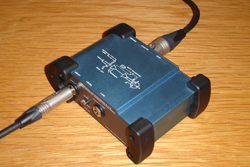I was asked a question on Twitter recently that I felt would make a good post. The question came from @tmlhjg and went like this:
“What is the advantage of phantom power DIs?”
I’m going to rephrase that to “Why choose an active or passive DI?” Before we get to that discussion, we should define what a DI or Direct Injection (aka Direct Interface) does. (By the way, they’re also commonly called “direct boxes.”)
A DI connects high impedance sources to the console. When we have to hook up instruments with high impedance outputs—keyboards, guitars, practically anything with a 1/4-inch jack—to a mixer, we could just run a long 1/4-inch cord. But, most of the time, those outputs are unbalanced and, being high impedance, will pick a lot of noise and loose a lot of signal along the way to the console.
What a DI does is simultaneously lower the impedance so the signal can travel farther, and balance it so it’s more resistant to noise. A DI works this little bit of magic either through a passive transformer circuit or some active circuitry. With that little bit of theory out of the way, let’s compare the two designs.
Passive DIs require no power to work, and this is one of the big advantages over active models. There is no battery to die, no amplifier to overload and distort; you just plug it in and it works.
Unlike active circuitry which can distort when the incoming signal is too hot, a transformer simply saturates somewhat like a tube. This saturation can sound quite pleasant, and often DIs will be chosen for a given application based on how they sound when they saturate.
With a passive direct box, it’s also easy to eliminate ground loops caused by DC offsets, or varying voltage potential on the ground pin between the stage and console. A simple ground lift switch safely lifts pin one, breaking the loop. This can be done on active units, but it requires more design and circuitry (and more cost) to keep from loosing phantom power when pin one is lifted.
By the way, never use a ground lifting adapter on a power connector. Those so-called “cheater plugs” may stop a ground loop, but also leave the device in question dangerously ungrounded, which could kill someone. Use a DI instead.





















